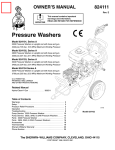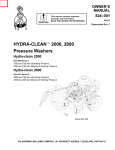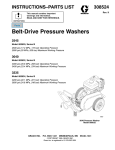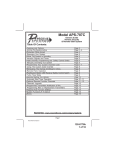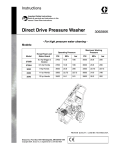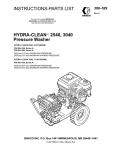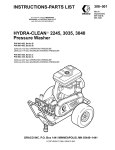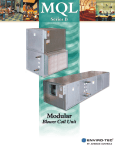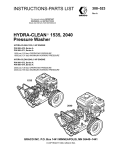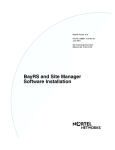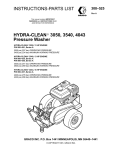Download Sherwin-Williams 824104 Owner`s manual
Transcript
This manual contains important warnings and information. READ AND RETAIN FOR REFERENCE OWNER’S MANUAL 824111 Rev C Pressure Washer Model 824101, Series A 2030 Pressure Washer on Upright cart with hose and gun 2400 psi (165 bar, 16.5 MPa ) Maximum Working Pressure Model 824102, Series A 2835 Pressure Washer on Upright cart with hose and gun 3200 psi (221 bar, 22.1 MPa ) Maximum Working Pressure Model 824103, Series A 3040 Pressure Washer on Upright cart with hose and gun 3400 psi (234 bar, 23.4 MPa ) Maximum Working Pressure Model 824104 Series A 3340 Pressure Washer on Upright cart with hose and gun 8777B 3700 psi (255 bar, 25.5 MPa ) Maximum Working Pressure U.S. PATENT NO. PATENTED 1983, CANADA AND OTHER PATENTS PENDING Related Manuals Spray Gun . . . . . . . . . . . . . . . . . . . . . . . . . . . . . . . 308511 MODEL 824102 8777B The SHERWIN–WILLIAMS COMPANY, CLEVELAND, OHIO 44115 ECOPYRIGHT 1998, GRACO INC. Table of Contents Warnings . . . . . . . . . . . . . . . . . . . . . . . . . . . . . . . . . . . . . . 2 Installation . . . . . . . . . . . . . . . . . . . . . . . . . . . . . . . . . . . . . 4 Operation . . . . . . . . . . . . . . . . . . . . . . . . . . . . . . . . . . . . . 5 Troubleshooting . . . . . . . . . . . . . . . . . . . . . . . . . . . . . . . . 9 824101 Pump Service . . . . . . . . . . . . . . . . . . . . . . . . . 11 824102, 824103, 824104 Pump Service . . . . . . . . . 13 Accessories . . . . . . . . . . . . . . . . . . . . . . . . . . . . . . . . . . 15 Technical Data . . . . . . . . . . . . . . . . . . . . . . . . . . . . . . . . 15 Parts List & Drawing 2030 Pressure Washer . . . . . . . . . . . . . . . . . . . . . . . 16 2835, 3040, 3340 Pressure Washer . . . . . . . . . . . . 18 Sherwin-Williams Warranty . . . . . . . . . . . . . . . . . . . . . 20 Graco Phone Number . . . . . . . . . . . . . . . . . . . . . . . . . . 20 Warning Symbol WARNING This symbol alerts you to the possibility of serious injury or death if you do not follow the instructions. Caution Symbol CAUTION This symbol alerts you to the possibility of damage to or destruction of equipment if you do not follow the instructions. WARNING INJECTION HAZARD Spray from the gun, leaks or ruptured components can inject fluid into your body and cause serious injury. Fluid splashed in the eyes or on the skin can also cause serious injury. D Fluid injected into the skin may look like just a cut, but it is a serious injury. Get emergency medical attention. D Do not point gun at anyone or at any part of body. D Do not stop or deflect leaks with hand, body, glove or rag. D Do not put hand or fingers over spray tip. D Tighten fluid connections before starting equipment. D Engage the gun trigger safety whenever you stop spraying. D Follow Pressure Relief Procedure on page 5 if spray tip clogs and before cleaning, checking or servicing equipment. D Repair or replace worn or damaged parts immediately. D Check hoses, tubes, and coupling daily. Do not repair high pressure couplings: replace entire hose. Fluid hoses must have spring guards on both ends to prevent kinks and rupture. 2 824111 WARNING HAZARDOUS FLUIDS Improper handling of hazardous fluids can cause serious injury, even death, due to splashing in eyes, ingestion or bodily contamination. D Know specific hazards of fluid being used. D Store hazardous fluids in approved containers. Dispose of hazardous fluids per local, state and national guidelines. D Wear protective eyewear, gloves, clothing, and respirator as recommended by the fluid manufacturer. FUEL HAZARD The fuel used in this unit is combustible and when spilled on a hot surface can ignite and cause a fire. D Do not fill the fuel tank while the engine is running or hot. EXHAUST HAZARD The exhaust contains poisonous carbon monoxide which is colorless and odorless. D Do not operate this equipment in a closed building. EQUIPMENT MISUSE HAZARD Misuse of the pressure washer or accessories may cause them to rupture and result in fluid injection, splashing in the eyes or on the skin, or other serious injury. D Do not alter or modify any part or factory-set adjustment of this equipment. D Do not exceed the maximum working pressure of any component or accessory in the system. D Do not use any chemicals that are incompatible with the wetted parts as stated in the Technical Data. D Do not alter throttle setting. 824111 3 Installation Typical Installation – Pressure Washer SPRAY GUN HOSE RACK SPRAY HOSE Fig. 1 INLET WATER CONNECTION 3/4” GARDEN HOSE HIGH PRESSURE HOSE CONNECTION Check for Shipping Damage Check the unit for any damage that may have occurred in shipping. Notify the carrier immediately if there is any damage. Set Up Connect the high pressure hose between the pump outlet and the gun inlet. Both of these connections are made with quick couplers. CAUTION Up to 100 ft (30 m) of high pressure hose may be used. Longer hoses may affect sprayer performance, and chemical injector performance, if used. Install the appropriate spray tip on the wand. See Installing and Changing Spray Tips. If you are using a sandblaster kit, see its separate manual for installation instructions. 4 824111 8777B Connect to Water Supply CAUTION Before attaching to the water supply, check your local plumbing code regarding cross–connection to the water supply. If required, a backflow preventer may be installed. If inlet water pressure is over 60 psi (4.1 bar), a regulating water valve must be installed at the garden hose connection. Do not exceed 160_F (70_C) inlet water temperature. Connect a hose with at least a 3/4 inch (19 mm) ID from the water supply to the unit’s 3/4 inch garden hose inlet. The supply hose should not be more than 50 ft (15 m) long NOTE: The water source at the unit must have a minimum flow rate equal to that of the unit (see Technical Data, inside back cover). Operation Pressure Relief Procedure WARNING INJECTION HAZARD The system pressure must be manually relieved to prevent the system from starting or spraying accidentally. Fluid under high pressure can be injected through the skin and cause serious injury. To reduce the risk of an injury from injection, splashing fluid, or moving parts, follow the Pressure Relief Procedure whenever you: D D D D are instructed to relieve the pressure, stop spraying for more than 10 minutes, check or service any of the system equipment, or install or clean the spray nozzle. Startup Always use this start–up procedure to ensure that the unit is started safely and properly. 1. Check oil levels: NOTE: All units are equipped with a low-oil sensor that shuts the engine off if the oil level falls below a certain level. If the unit stops unexpectedly, check both the oil and the fuel levels. Check the oil level each time the unit is refueled. 2. Check fuel level. Pressure Relief Procedure 1. Engage the trigger safety latch. 2. Turn the sprayer off. 3. Remove the ignition cable from the spark plug. 4. Shut off the water supply. 5. Disengage the trigger safety latch and trigger the gun to relieve pressure, and then engage the trigger safety latch again. 6. If you suspect that the spray tip or hose is completely clogged, or that pressure has not been fully relieved after following the steps above: Disengage the trigger safety latch and trigger the gun to relieve pressure. Wrap a rag around the hose end coupling and VERY SLOWLY loosen the coupling to relieve pressure gradually, then loosen completely. Now clear the tip or hose. WARNING FIRE HAZARD Do not refuel a hot engine. Refueling a hot engine could cause a fire. Use only fresh, clean regular or unleaded gasoline. Close the fuel shutoff valve during refueling. CAUTION Never run the unit dry. Costly damage to the pump will result. Always be sure the water supply is completely turned on before operating. 3. Turn on the water supply. 824111 5 Operation 4. Trigger the gun until water sprays from the tip indicating that the air is purged from the system. 5. Open the fuel shutoff valve. Be sure the spark plug ignition cable is pushed firmly onto the spark plug. Put the switch in the “on” position and put the throttle in the “run” position. CAUTION Do not allow the pressure washer to idle for more than 10 minutes. Doing so may cause the recirculating water to overheat and seriously damage the pump. Turn off the pressure washer if it will not be spraying or cleaning at least every 10 minutes. If heated inlet water is used, reduce this time further. Do not operate the pressure washer with the inlet water screen removed. This screen helps keep abrasive sediment out of the pump, which could clog the pump or damage the cylinders. Keep this screen clean. Do not pump caustic materials; such materials may corrode the pump components. CAUTION Do not allow the starter rope to snap back against the engine. Return it gently to prevent damage to the recoil. 6 824111 6. Start the engine. NOTE: For easier starting, have one person start the pressure washer while another person triggers the spray gun. If the engine is cold, completely close the engine choke. Grasp the starter rope, brace one foot on the pressure washer chassis and pull rope rapidly and firmly. Continue holding the rope as it returns. Pull and return the rope until the engine starts. In cool weather, the choke may have to be kept closed for 10 to 30 seconds before opening it to keep the engine running. Otherwise, open the choke as soon as the engine starts. If the engine is warm, leave the choke open, or just partly close it. Start the engine as described in the preceding paragraph. When it starts, be sure to open the choke completely. 7. Always engage the gun’s trigger safety latch whenever you stop spraying, even for a moment, to reduce the risk of fluid injection or splashing in the eyes or on the skin if the gun is bumped or triggered accidentally. 8. Always observe the following CAUTIONS to avoid costly damage to the pressure washer. 9. See the sandblaster kit manual for detailed cleaning information if this accessory is used. Operation Trigger Safety Latch Installing and Changing Spray Tips WARNING WARNING To reduce the risk of serious bodily injury, including fluid injection, splashing in the eyes or on the skin, always engage the trigger safety latch whenever spraying stops, even for a moment.In the engaged position, the trigger safety latch prevents the gun from being triggered accidentally by hand or if it is dropped or bumped. Be sure the latch is pushed fully down when engaging it or it cannot prevent the gun from being triggered. See Figure 2. To reduce the risk of serious bodily injury, including fluid injection or splashing in the eyes or onto the skin, use extreme caution when changing spray tips. always follow the procedure below. 1. Follow the Pressure Relief Procedure. 2. Point the gun and wand away from yourself and anyone else. 3. Spray tips have a 4– or 5–digit number on them. The first two digits are the spray angle. Select the spray tip appropriate for your application. ENGAGED DISENGAGED 04612 Spray Tip Number Spray Pattern Fan Angle 00XXX 0_, blaster (red) 15XXX 15_ (yellow) 25XXX 25_ (green) 40XXX 40_ (white) NOTE: The chemical injector tip is brass, has a large opening and a black plastic cap. TRIGGER SAFETY LATCH Figure 2 Chemical Injector Operation WARNING To reduce the risk of serious bodily injury, including fluid injection or splashing in the eyes or onto the skin, use extreme caution when changing spray tips. always follow the procedure below. 1. Follow the Pressure Relief Procedure. 2. Insert the chemical filter (attached with clear tubing to the chemical injector) into the container of chemical. 4. Without holding your hand over the spray tip (A), pull back the quick coupler ring (B). Remove the current tip and/or install a different one, and then push back the ring. See Figure 3. 5. Pull on the tip to be sure the tip is secure before starting to spray again. 6. Tip holding holes are provided on the chassis. CAUTION To avoid blowing the o-ring out of the quick coupler, due to the high pressure in the system, never operate the pressure washer without a tip securely mounted in the quick coupler. 3. Install the black large orifice chemical tip (see Installing and Changing Tips). B This causes a drop in pressure that actuates the chemical injector. Changing back to a small diameter spray tip deactivates the chemical injector and produces high pressure for rinsing. The chemical filter can be left in the chemical container during high pressure use. The flow rate of the chemical may be regulated+ by turning the chemical adjustment knob on the injector. Maximum chemical flow is a full two turns counterclockwise from the closed (clockwise) position. A 04929 Figure 3 824111 7 Operation Shutdown, Flushing and Storage NOTE: An anti–freeze flush kit 802327 is available to make flushing easier. CAUTION If water does freeze in the pressure washer, thaw it in a warm room before trying to start it. Do not pour hot water on or into the pump; it may crack the ceramic plungers! WARNING To reduce the risk of serious bodily injury, including fluid injection, splashing in the eyes or on the skin or injury from moving parts, always follow the Pressure Relief Procedure on page 5 before proceeding. Interval What to do Daily Clean water inlet screen and filter. Check engine and pump oil levels. Fill as necessary. Check gasoline level. Fill as necessary. After first 5 hours of operation Change engine break–in oil. Drain oil when warm. Use SAE 30 or 10W–30 detergent oil. After first 25 hours of operation Re-torque exhaust manifold nuts to 20 ft-lb (27 NSm). Do not over tighten. Each 25 hours of operation Clean and remove air cleaner foam. Wash with water and detergent. Dry thoroughly. Rub with oil and squeeze to distribute oil. Change pump break-in oil. Use SAE 20 or 30 non-detergent oil. Maintenance After first 50 hours of operation Observing regular maintenance intervals helps ensure that you get maximum performance and life from the pressure washer. Each 100 hours of operation or 3 months Clean or replace paper air cleaner cartridge. Tap gently to remove dirt. Change engine oil. Use SAE 30 or 10W–30 detergent oil. 1. If the pressure washer will be exposed to freezing temperatures, drain all water out of the pump. If it must be stored in freezing temperatures, flush the unit with a 50% anti–freeze solution. Relieve pressure. Flush the pressure washer before using it again to remove the anti–freeze. 2. Before long-term (overnight) storage or transporting of unit, disconnect the water supply, and turn off the fuel supply valve. 3. After each use, wipe all surfaces of the pressure washer with a clean, damp cloth. 4. Perform the appropriate maintenance. See maintenance chart. There is a break-in period for the engine and pump. After changing the oil in these components following their respective break-in periods, the interval between required changes is longer. If the unit is operating in dusty conditions, these maintenance checks should be made more often. 8 824111 Re-torque exhaust manifold nuts to 20 ft-lb (27 NSm). Do not over tighten. Each 500 hours of operation or 6 months Change pump oil. Use SAE 20 or 30 non-detergent oil. Troubleshooting WARNING To reduce the risk of serious injury, including fluid injection and splashing in the eyes, or on the skin, always follow Pressure Relief Procedure on page 5 before proceeding. Problem Engine will not start or is hard to start Cause Solution No gasoline in fuel tank or carburetor. Fill the tank with gasoline, open fuel shut off valve. Check fuel line and carburetor. Low oil. Add to proper level. Start/Stop switch in Stop position. Move switch to start position. Water in gasoline or old fuel. Drain fuel tank and carburetor. Use new fuel and dry spark plug. Choked improperly. Flooded engine. Open choke and pull engine several times to clear out gas. Use a dry spark plug. Dirty air cleaner filter. Remove and clean. Spark plug dirty, wrong gap or wrong type. Clean, adjust the gap or replace. Spray gun closed. Trigger spray gun while spraying. Partially plugged air cleaner filter. Remove and clean. Spark plug dirty, wrong gap or wrong plug type. Clean, adjust the spark plug gap or replace. Worn or wrong size tip. Replace with tip of proper size. Inlet filter clogged. Clean. Check more frequently. Worn packings, abrasives in water or natural wear. Check filter. Replace packings. See PUMP SERVICE, page 13. Inadequate water supply. Check water flow rate to pump. Fouled or dirty inlet or discharge valves. Clean inlet and discharge valve assemblies. Check filter. Restricted inlet. Check garden hose, may be collapsed or kinked. Worn inlet or discharge valves. Replace worn valves. See PUMP SERVICE, page 13. Leaking high pressure hose. Replace high pressure hose. Water leakage from under pump manifold Worn packings. Install new packings. See PUMP SERVICE, page 13.. Water on oil side of pump Humid air condensing inside crankcase. Change oil as specified in Maintenance, page 8. Worn packings. Install new packings. See PUMP SERVICE, page 13. Oil seals leaking. Install new oil seals. See PUMP SERVICE, page 13. Engine misses or lacks power Low pressure and/or pump runs rough 824111 9 Troubleshooting Problem Frequent or premature failure of the packings Strong surging at inlet and low pressure on discharge side 10 824111 Cause Solution Scored, damaged or worn plungers. Install new plungers. See PUMP SERVICE, page 13. Abrasive material in the fluid being pumped. Install proper filtration on pump inlet plumbing. Inlet water temperature too high. Check water temperature; may not exceed 160_F(70_C). Over pressurizing pump. Do not modify any factory–set adjustments. See EQUIPMENT MISUSE HAZARD on page 3. Excessive pressure due to partially plugged or damaged tip. Clean or replace tip. See Installing and Changing Spray Tips on page 7. Pump running too long without spraying. Never run pump more than 10 minutes without spraying. Running pump dry. Do not run pump without water. Foreign particles in the inlet or discharge valve or worn inlet and/or discharge valves. Clean or replace valves. See PUMP SERVICE, page 13. 824101 Pump Service WARNING To reduce the risk of serious bodily injury, including fluid injection, splashing in the eyes or on the skin or injury from moving parts, always follow the Pressure Relief Procedure on page 5 before proceeding. NOTE: NOTE: The following metric wrenches are needed: 5 mm, 13 mm and 22 mm. Repair kits are available. Refer to the individual repair sections and the pump parts page for more details. For the best results, use all parts in the kits. There is a tool kit to aid in servicing the pump. Tool kit 800271 includes tools to aid in the removal of packing retainers. Valves NOTE: For a set of six valves, order 801472. 1. Remove the hex plug from the manifold using a 22 mm socket. 2. Examine the o–ring under the hex plug and replace it if it is cut or distorted. 3. Remove the valve assembly from the cavity; the assembly may come apart. 4. Install the new valve. Install the o–ring and hex plug; torque to 33 ft–lb (45 N@m). NOTE: Retorque the plug after 5 hours of operation. Pumping Section 1. Remove the eight capscrews and lockwashers from the manifold using a 5 mm wrench. 2. Carefully separate the manifold from the crankcase. NOTE: It may be necessary to tap the manifold lightly with a soft mallet to loosen. CAUTION Keep the manifold properly aligned with the ceramic plungers when removing to avoid damage to the plunger or seals. 3. Carefully examine each plunger for any scoring or cracking and replace as necessary. Servicing the Plungers NOTE: Plunger repair kit (page 15) is available to replace retainers, o–rings, washers and backup rings for three cylinders. 1. Loosen the plunger retaining nut five to six turns, using a 13 mm wrench. Push the plunger towards the crankcase to separate the plunger and retaining screw. 2. Remove the nut from the plunger and examine the o–ring, backup ring and copper bearing/gasket washer. Replace these parts, if necessary, using kit 801474. 3. Remove the plunger and flinger from the plunger shaft. Clean, examine and replace parts as necessary. 4. Inspect the plunger shaft for oil leakage from the crankcase. If leaking is obvious, replace the oil seals. Otherwise, DO NOT remove these seals as they cannot be reused. An oil seal kit is available to replace the seals. 5. Lightly grease the flinger and oil seal, if it is being replaced and replace them on the plunger shaft. Then install the plunger. 824111 11 824101 Pump Service 6. Lightly grease the retaining screw and the outer end of the plunger. Place the washer, o–ring and backup ring around the screw and install the nut through the plunger. Torque to 11 ft–lb (15 N@m). NOTE: If you plan to replace the packings, refer to Servicing the V–Packings. 7. Lubricate the outside of each plunger. Slide the manifold onto the crankcase, being careful not to damage the seals. 8. Install the capscrews and washers finger–tight. Torque the screws to 8.8 ft–lb (12 N@m) following the tightening pattern (Figure 4). Uneven tightening may cause the manifold to bind or jam. 5 1 4 7 8 3 2 6 Servicing the V-Packings NOTE: There are two types of packing kits: one is packings only, the other includes the packings, rings and retainers. 1. Remove the manifold as outlined in the Pumping Section. 2. Carefully pull the packing retainer from the manifold. Examine the o-ring and replace it if it is cut or damaged. 3. Remove the v-packing and head ring. Pull out the intermediate retainer ring. Remove the second v–packing and second head ring. 4. Inspect all parts and replace as necessary. 5. Thoroughly clean the packing cavities and examine for debris or damage. 6. Lightly grease the packing cavities and then replace the packings in the following order: head ring, v-packing, intermediate ring, head ring, v-packing and packing retainer with the o-ring installed in the retainer groove. CAUTION Install the parts in the proper order and facing the correct direction. Improperly installed parts will cause a malfunction. Figure 4 12 824111 7. Reassemble the manifold as instructed in Servicing the Plungers. 824102, 824103, 824104 Pump Service WARNING To reduce the risk of serious bodily injury, including fluid injection, splashing in the eyes or on the skin or injury from moving parts, always follow the Pressure Relief Procedure on page 5 before proceeding. NOTE: NOTE: The following metric wrenches are needed: 6 mm, 13 mm and 27 mm. Repair kits are available. Refer to the individual repair sections and the pump parts page for more details. For the best results, use all parts in the kits. There is a tool kits to aid in servicing the pump. Tool kit 800271 includes tools to aid in the removal of packing retainers. Valves NOTE: For a set of six valves, order 801472. 1. Remove the hex plug from the manifold using a 27 mm socket. 2. Examine the o–ring under the hex plug and replace it if it is cut or distorted. 3. Remove the valve assembly from the cavity; the assembly may come apart. 4. Install the new valve. Install the o–ring and hex plug; torque to 73 ft–lb (99 N@m). NOTE: Retorque the plug after 5 hours of operation. Pumping Section 1. Remove the eight capscrews and lockwashers from the manifold using a 6 mm wrench. 2. Carefully separate the manifold from the crankcase. NOTE: It may be necessary to tap the manifold lightly with a soft mallet to loosen. CAUTION Keep the manifold properly aligned with the ceramic plungers when removing to avoid damage to the plunger or seals. 3. Carefully examine each plunger for any scoring or cracking and replace as necessary. Servicing the Plungers NOTE: Plunger repair kit (page 15) is available to replace retainers, o–rings, washers and backup rings for three cylinders. 1. Loosen the plunger retaining nut five to six turns, using a 13 mm wrench. Push the plunger towards the crankcase to separate the plunger and retaining screw. 2. Remove the nut from the plunger and examine the o–ring, backup ring and copper bearing/gasket washer. Replace these parts, if necessary, using kit 801474. 3. Remove the plunger and flinger from the plunger shaft. Clean, examine and replace parts as necessary. 4. Inspect the plunger shaft for oil leakage from the crankcase. If leaking is obvious, replace the oil seals. Otherwise, DO NOT remove these seals as they cannot be reused. An oil seal kit is available to replace the seals. 5. Lightly grease the flinger and oil seal, if it is being replaced and replace them on the plunger shaft. Then install the plunger. 824111 13 824102, 824103, 824104 Pump Service 6. Lightly grease the retaining screw and the outer end of the plunger. Place the washer, o–ring and backup ring around the screw and install the nut through the plunger. Torque to 14.4 ft–lb (19.5 N@m). NOTE: If you plan to replace the packings, refer to Servicing the V–Packings. 7. Lubricate the outside of each plunger. Slide the manifold onto the crankcase, being careful not to damage the seals. 8. Install the capscrews and washers finger–tight. Torque the screws to 22 ft–lb (30 N@m) following the tightening pattern (Fig. 4). Uneven tightening may cause the manifold to bind or jam. 5 1 4 7 8 3 2 6 Servicing the V-Packings NOTE: There are two types of packing kits: one is packings only, the other includes the packings, rings and retainers. 1. Remove the manifold as outlined in the Pumping Section. 2. Carefully pull the packing retainer from the manifold. Examine the o-ring and replace it if it is cut or damaged. 3. Remove the v-packing and head ring. Pull out the intermediate retainer ring. Remove the second v–packing and second head ring. 4. Inspect all parts and replace as necessary. 5. Thoroughly clean the packing cavities and examine for debris or damage. 6. Lightly grease the packing cavities and then replace the packings in the following order: head ring, v-packing, intermediate ring, head ring, v-packing and packing retainer with the o-ring installed in the retainer groove. CAUTION Install the parts in the proper order and facing the correct direction. Improperly installed parts will cause a malfunction. Figure 4 14 824111 7. Reassemble the manifold as instructed in Servicing the Plungers. Accessories Anti–freeze Flush Kit 802327 For flushing system with 50% anti-freeze solution prior to transporting or storing pressure washer in below freezing temperatures. Pump Repair Kits Repair Kit Description Qty. Model 824101 Model s 824102 and 824103 Model 824104 804033 Oil Seal 801658 Oil Seal 801658 Oil Seal SEAL, Oil 801472 Valve Assembly 804402 Valve Assembly 804402 Valve Assembly O-RING SEAT, Valve VALVE SPRING CAGE, Valve 6 6 6 6 6 Entire Pump One Cyl 3 * 804034 Valve Cap 804403 Valve Cap 804403 Valve Cap O-RING CAP 6 6 804036 Packing Assembly 804404 Packing Assembly 114793 Packing Assembly O-RING RETAINER, Packing RING, Intermediate PACKING PACKING RING, Head 1 1 1 1 2 2 801474 Plunger Assembly 243430 Plunger Assembly 241325 Plunger Assembly WASHER O-RING BACK UP SCREWS, retaining FLINGER 3 3 3 3 3 804011 Plunger 804415 Plunger 804415 Plunger Plunger 1 * * * * * * Designates whether kit contains parts for entire pump or for only one cylinder. Technical Data Model 824101 Model 824102 Model 824103 Model 824104 Engine (4 cycle, air cooled) 5.5 HP Honda OHV 9 HP Honda OHV 11 HP Honda OHV 13 HP Honda OHV Gasoline Tank Capacity 3.8 quarts (3.6 liter) 6.2 quarts (6.1 liter) 6.9 quarts (6.5 liter) 6.9 quarts (6.5 liter) Water Pump Maximum Working Pressure Water Pump Maximum Flow 2400 psi (165 bar) 3 gpm (11 lpm) 3200 psi (193 bar) 3.5 gpm (13 lpm) 3400 psi (234 bar) 4 gpm (15 lpm) 3700 psi (255 bar) 4 gpm (15 lpm) Inlet Hose Connection 3/4” garden hose (f) 3/4” garden hose (f) 3/4” garden hose (f) 3/4” garden hose (f) Weight (without gun and hose) 103 lb (47 kg) 142 lb (64 kg) 151 lb (69 kg) 151 lb (69 kg) Dimensions Length 36.5” (927mm) 36.5” (927mm) 36.5” (927mm) 36.5” (927mm) Width 22” (533mm) 22” (533mm) 22” (533mm) 22” (533mm) Height 31.5” (788mm) 31.5” (788mm) 32.5” (813mm) 32.5” (813mm) Maximum Inlet Water Temperature 160_F (70_C) 160_F (70_C) 160_F (70_C) 160_F (70_C) Sound Data in dB(A) Sound Pressure Sound Level 93.1 103.5 94.3 104.7 95.8 106.3 97.4 111.6 Wetted Parts High Pressure Hose Bypass Hose Pressure Washer (including fittings) Acrylonitrile and Buna-N cover and tube Synthetic yarn and EPDM Anodized aluminum, Aluminum or bronze alloys, Brass Copper, Nylon–PTFE r composite, Ceramic, Buna-N, Cotton phenolic, 303, 304, and 316 Stainless steel, Polymide–12 thermoplastic,PTFE , Carbon steel, Zinc with or without yellow chromate plate PTFE 824111 15 2030 Pressure Washer – Parts Model 824101, Series A 1 Apply sealant to threads 2 Supplied with pump 3 Supplied with engine 4 All parts supplied with unloader 4 39 5 9 1 Detail 1 4 3 1 6 49 2 7 2 47 48 Detail 1 1 16 14 24 31 3 10 11 39 12 30 23 25 15 40 13 50 17 8 27 18 19 20 21 22 3 Ref 26 8779B 16 824111 2030 Pressure Washer – Parts USE ONLY GENUINE GRACO PARTS AND ACCESSORIES Model 824101, Series A Ref. No. Part No. 1 2 3 4 5 6 7 8 9 10 11 12 13 14 15 16 17 18 19 802264 804531 240998 239998 191084 183350 110243 115481 112827 179811 154636 101242 104811 110837 111040 108795 801012 805543 805544 20 805545 Description Qty. ENGINE, 5.5 hp PUMP ASSEMBLY FRAME, cart HANDLE, cart SLEEVE, cart WASHER RING, retaining FOOT, cart BUTTON, snap WHEEL, semi-pneumatic WASHER RING, retaining. ext CAP, hub SCREW, flange, hex hd, 5/16 in. NUT, lock, nylock 5/16–18 in. SCREW, mach, pan hd GROMMET, rubber TIP, spray, Q-type, (0_ - red), 0004 TIP, spray, Q-type, (15_ - yellow), 1504 TIP, spray, Q-type, (25_ - green), 2504 1 1 1 1 2 2 2 2 2 2 2 2 2 4 4 4 6 1 1 Ref. No. 21 Part No. 805546 22 805520 23 114801 24 112380 25 109466 26 804381 27 804592 30 801683 31 194188 39Y290013 40Y290131 46 190781 47 804543 48 800742 49 804542 50 115496 Description Qty. TIP, spray, Q-type, 1 (40_ - white), 4004 TIP, spray, chemical injector, (black)1 HOOK, pail 1 SCREW, mach, fil hd, 1/2 in. 2 LOCKNUT 2 GUN & WAND ASSEMBLY 1 HOSE, high pressure 3/8 x 50 ft 1 STRAINER, chemical 1 TUBING, chemical 1 LABEL, danger 1 LABEL, warning 1 TUBE, polyethylene 1 KIT, unloader/injector 1 VALVE, thermal relief 1 VALVE, relief 1 SCREW, thread forming, pnhd 2 Y Extra warning labels available free of charge. 1 824111 17 2835, 3040, 3340 Pressure Washer – Parts Model 824102, Series A Model 824103, Series A Model 824104, Series A 1 Apply sealant to threads 2 All parts supplied with unloader 3 Supplied with pump 4 5 9 1 Detail 1 2 1 49 6 50 3 7 2 47 Detail 1 48 16 1 14 24 31 3 10 11 39 12 30 23 25 40 15 13 51 17 8 27 18 19 20 21 22 3 Ref 26 8778B 18 824111 2835, 3040, 3340 Pressure Washer – Parts USE ONLY GENUINE GRACO PARTS AND ACCESSORIES Models 824102, Series A; 824103, Series A; 824104, Series A Ref. No. Part No. 1 803900 803158 114703 2 3 4 5 6 7 8 9 10 11 12 13 14 15 16 17 18 804559 804503 114707 240998 239998 191084 183350 110243 115481 112827 179811 154636 101242 104811 110837 111040 108795 801012 805543 805547 19 805544 805548 20 805545 805549 Description Qty. ENGINE Model 824102, 9 hp Model 824103, 11 hp Model 824104, 13 hp PUMP ASSEMBLY Model 824102, 2835 Model 824103, 3040 Model 824104, 3340 FRAME, cart HANDLE, cart SLEEVE, cart WASHER RING, retaining FOOT, cart BUTTON, snap WHEEL, semi-pneumatic WASHER RING, retaining. ext CAP, hub SCREW, flange, hex hd, 5/16 in. NUT, lock, nylock 5/16–18 in. SCREW, mach, pan hd GROMMET, rubber TIP, spray, Q-type, (0_ - red) Models 824102 and 824104 (0004) Model 824103 (00045) TIP, spray, Q-type, (15_ - yellow) Models 824102 and 824104 (1504) Model 824103 (15045) TIP, spray, Q-type, (25_ - green) Models 824102 and 824104 (2504) Model 824103 (25045) 1 1 1 1 1 1 1 1 1 1 2 2 2 2 2 2 2 2 2 4 4 4 6 1 1 1 1 Ref. No. Part No. 21 22 23 24 25 26 27 805546 805550 805520 114801 112380 109466 804381 804592 800747 30 801683 31 194188 39Y290013 40Y290131 46 190781 47 804567 804528 114706 48 804397 49 804536 804547 114705 50 801137 51 115496 Description Qty. TIP, spray, Q-type, (40_ - white) Models 824102 and 824104 (4504) Model 824103 (45045) TIP, spray, chemical injector,(black) HOOK, pail SCREW, mach, fil hd, 1/2 in. LOCKNUT GUN & WAND ASSEMBLY HOSE, high pressure 3/8 x 50 ft Model 824102 Models 824103 and 824104 STRAINER, chemical TUBING, chemical LABEL, danger LABEL, warning TUBE, polyethylene KIT, unloader/injector Model 824102, 9 hp Model 824103, 11 hp Model 824104, 13 hp VALVE, thermal relief VALVE, relief Model 824102, 9 hp Model 824103, 11 hp Model 824104, 13 hp KEY, square SCREW, thread forming, pnhd 1 1 1 1 2 2 1 1 1 1 1 1 1 1 1 1 1 1 1 1 1 1 1 1 2 Y Extra warning labels available free of charge. 1 1 824111 19 Sherwin-Williams Standard Warranty Graco warrants all equipment referenced in this document which is manufactured by Graco and bearing its name to be free from defects in material and workmanship on the date of sale by an authorized Graco distributor to the original purchaser for use. With the exception of any special, extended, or limited warranty published by Graco, Graco will, for a period of twelve months from the date of sale, repair or replace any part of the equipment determined by Graco to be defective. This warranty applies only when the equipment is installed, operated and maintained in accordance with Graco’s written recommendations. This warranty does not cover, and Graco shall not be liable for general wear and tear, or any malfunction, damage or wear caused by faulty installation, misapplication, abrasion, corrosion, inadequate or improper maintenance, negligence, accident, tampering, or substitution of non–Graco component parts. Nor shall Graco be liable for malfunction, damage or wear caused by the incompatibility of Graco equipment with structures, accessories, equipment or materials not supplied by Graco, or the improper design, manufacture, installation, operation or maintenance of structures, accessories, equipment or materials not supplied by Graco. This warranty is conditioned upon the prepaid return of the equipment claimed to be defective to an authorized Graco distributor for verification of the claimed defect. If the claimed defect is verified, Graco will repair or replace free of charge any defective parts. The equipment will be returned to the original purchaser transportation prepaid. If inspection of the equipment does not disclose any defect in material or workmanship, repairs will be made at a reasonable charge, which charges may include the costs of parts, labor, and transportation. THIS WARRANTY IS EXCLUSIVE, AND IS IN LIEU OF ANY OTHER WARRANTIES, EXPRESS OR IMPLIED, INCLUDING BUT NOT LIMITED TO WARRANTY OF MERCHANTABILITY OR WARRANTY OF FITNESS FOR A PARTICULAR PURPOSE. Graco’s sole obligation and buyer’s sole remedy for any breach of warranty shall be as set forth above. The buyer agrees that no other remedy (including, but not limited to, incidental or consequential damages for lost profits, lost sales, injury to person or property, or any other incidental or consequential loss) shall be available. Any action for breach of warranty must be brought within two (2) years of the date of sale. GRACO MAKES NO WARRANTY, AND DISCLAIMS ALL IMPLIED WARRANTIES OF MERCHANTABILITY AND FITNESS FOR A PARTICULAR PURPOSE, IN CONNECTION WITH ACCESSORIES, EQUIPMENT, MATERIALS OR COMPONENTS SOLD BUT NOT MANUFACTURED BY GRACO. These items sold, but not manufactured by Graco (such as electric motors, switches, hose, etc.), are subject to the warranty, if any, of their manufacturer. Graco will provide purchaser with reasonable assistance in making any claim for breach of these warranties. In no event will Graco be liable for indirect, incidental, special or consequential damages resulting from Graco supplying equipment hereunder, or the furnishing, performance, or use of any products or other goods sold hereto, whether due to a breach of contract, breach of warranty, the negligence of Graco, or otherwise. FOR GRACO CANADA CUSTOMERS The parties acknowledge that they have required that the present document, as well as all documents, notices and legal proceedings entered into, given or instituted pursuant hereto or relating directly or indirectly hereto, be drawn up in English. Les parties reconnaissent avoir convenu que la rédaction du présente document sera en Anglais, ainsi que tous documents, avis et procédures judiciaires exécutés, donnés ou intentés à la suite de ou en rapport, directement ou indirectement, avec les procedures concernées. ADDITIONAL WARRANTY COVERAGE Graco does provide extended warranty and wear warranty for products described in the “Graco Contractor Equipment Warranty Program”. Phone Number TO PLACE AN ORDER, contact your Graco distributor, or call this number to identify the distributor closest to you: 1–800–690–2894 Toll Free All written and visual data contained in this document reflects the latest product information available at the time of publication. Graco reserves the right to make changes at any time without notice. The SHERWIN–WILLIAMS COMPANY, 101 PROSPECT AVENUE, CLEVELAND, OHIO 44115 20 824111 PRINTED IN U.S.A. 824111 December 1998, Revised 12/1999




















